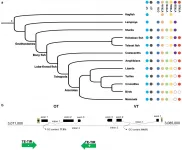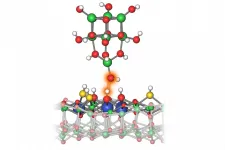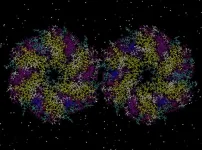(Press-News.org) Oxytocin and arginine vasopressin are two hormones in the endocrine system that can act as neurotransmitters and regulate -in vertebrates and invertebrates- a wide range of biological functions, such as bonding formation, breastfeeding, birth or arterial pressure. Biochemists in the pregenomic era, named these genes differently in different species, due to small protein coding differences.
A new study carried out by the University of Barcelona (UB) and the Rockefeller University, published in the journal Nature, has analysed and compared the genome of 35 species representing all vertebrate lineages and reached the conclusion that both hormones stem from a common ancestral gene.
These high-quality genomes were obtained thanks to the use of innovative genome sequencing technologies in the context of the Vertebrate Genomes Project. Based on these findings, the researchers propose a new universal nomenclature, based on their identified evolutionary history for these genes. According to the authors of the study, the proposal allows for a new nomenclature that is universal across vertebrates, both for the hormone-genes and their receptors, therefore easing the species comparative research.
The paper is part of the doctoral thesis by Constantina Theofanopoulou, carried out at the UB under the co-supervision of Cedric Boeckx, ICREA researcher at the Institute of Complex Systems of the UB (UBICS) and Erich D. Jarvis, professor at the Rockefeller University.
Terminological confusion between species
The study results from problems the first author of the study, Constantina Theofanopoulou, became aware of in the literature of these genes, when analysing the role of oxytocin in the vocal learning ability in songbirds. "When analysing the scientific literature to find previous work on this gene, we observed that when talking about birds, scientists used the term 'mesotocin', instead of 'oxytocin'. Different names, like 'isotocin' or 'neurophysin' were used in other vertebrate species, such as turtles, frogs or fish. An equally confusing nomenclature was the one used for their respective receptors, making it very difficult to understand which gene is which in different species and lineages", says Constantina Theofanopoulou. In this context, the researchers aimed to find out which genes were truly orthologous to each other in different species. To do so, they used the genome assemblies generated by the Vertebrates Genome Project, an international collaboration led by Erich Jarvis, from the Rockefeller University. In the first phase, Theofanopoulou and the research team compared the genomes and specifically the order of genes around their genes of interest. They studied up to sixty genes around the genes of interest, as well as all the genes of the chromosomes where these genes are located. They sought to find out whether the order of genes -called synteny- was conserved across species, something that would shed light to the evolutionary history of these genes.
The new high-quality assemblies were more than helpful since, as Theofanopoulou says, "Most genomes so far have had low quality, meaning millions of mistakes, parts of genes being absent or incorrectly assembled. These errors can have direct consequences on the scientific findings".
Genes with a common ancestor
The results, together with other phylogenetic analyses carried out during the study, show that genes that the researchers of this study now call oxytocin and vasotocin -that code for the homonymous hormones- are paralogous, that is, they come from a local duplication of a common ancestral gene. "Our findings suggest that the oxytocin gene is a duplication of the vasotocin gene -historically called vasopressin- that took place after the divergence of jawed vertebrates from jawless vertebrates. This simultaneously means that, if we had understood the evolution of these genes from the very beginning, we would most likely not have used different names to refer to them, as we see in other gene families, where we use the same root name for all its gene-members (e.g., FOXP) and different numbers to differentiate them (e.g., FOXP1, FOXP2 etc.)", highlights Constantina Theofanopoulou.
Given the results, the researchers propose a universal nomenclature in which oxytocin and vasotocin are used for these genes in all jawed vertebrates, and vasotocin for the only gene present all jawless vertebrates and closely related invertebrates. In this proposal, the common origin of both genes would be represented through the shared suffix -tocin, while the parology would be displayed through the different prefixes (oxy- and ¬vaso-). Following this new proposed nomenclature, what is currently called oxytocin, mesotocin, isotocin, glumitocin, valitocin, aspargtocin and neurophysin in different lineages, would be now called oxytocin universally. As for what is currently named vasotocin, vasopressin, neurophysin 2 and phenypresin in different species, would now be called vasotocin for all species.
This proposal also includes a universal nomenclature for the receptors of both genes, being oxytocin and vasotocin receptors (OTR and VTRs). Therefore, what has traditionally been called oxytocin receptor (OXTR) in mammals, vasotocin 3 receptor (VT3) and mesotocin receptor (MTR) in birds and frogs, and isotocin receptor (ITR) in fish, would be now called oxytocin receptor (OTR) in all cases.
Evolutionary history of oxytocin and vasotocin
The study also identified six main receptors of oxytocin and vasotocin in jawed vertebrates, with two of them being present already in the hagfish, two additional in lampreys, which have four receptors in total, and two more in jawed, which display six receptors in total. This pattern suggests that these receptors have first evolved through one round of whole genome duplication that gave rise to the four receptors we find in jawless vertebrates, like the lampreys, and that afterwards either smaller-scale segmental duplications or another whole genome duplication gave rise to the six receptors in jawed vertebrates.
This is the second time researchers find evidence for a scenario with one round of whole genome duplication, instead of two. The hypothesis that vertebrate genomes have evolved through two rounds of whole genome duplication has not been challenged in almost fifty years. "Our data show more support for the one round of whole genome duplication-idea. If the two rounds of whole genome duplication were the case, we would expect to find eight in total and not six receptors in jawed vertebrates. Of course, gene loss is very common, so that's why we can't exclude a two round-scenario, but we did not find any genomic sign of gene loss in any of the jawed vertebrate genomes we studied", notes the researcher.
The next step would be to get this new nomenclature, which is based on the evolutionary history of genes, adopted. "This is the first time that such a universal change affecting so many genes and species is being presented. Regardless of whether this proposal will be adopted or not, researchers will now have a guide on the genetic orthologies among species, which will make their research much easier", concludes Constantina Theofanopoulou.
INFORMATION:
Researchers have discovered an explanation for why cerebral cavernous malformations (CCMs)--clusters of dilated blood vessels in the brain--can suddenly grow to cause seizures or stroke. Specifically, they found that a specific, acquired mutation in a cancer-causing gene (PIK3CA) could exacerbate existing CCMs in the brain. Furthermore, repurposing an already existing anticancer drug showed promise in mouse models of CCMs in improving brain-vascular health and preventing bleeding into the brain tissue.
Previous studies linked the initial formation of CCMs to various environmental factors, including ...
The degree of acidity or alkalinity of a substance is crucial for its chemical behavior. The decisive factor is the so-called proton affinity, which indicates how easily an entity accepts or releases a single proton. While it is easy to measure this for molecules, it has not been possible for surfaces. This is important because atoms on surfaces have very different proton affinities, depending on where they sit.
Researchers at TU Wien have now succeeded in making this important physical quantity experimentally accessible for the first time: Using a specially modified atomic force microscope, it is possible to study the proton affinity of individual atoms. This should help to analyze catalysts on an atomic scale. The results have been published in the scientific journal Nature.
Precision ...
COLUMBUS, Ohio - Tiny molecules called nanobodies, which can be designed to mimic antibody structures and functions, may be the key to blocking a tick-borne bacterial infection that remains out of reach of almost all antibiotics, new research suggests.
The infection is called human monocytic ehrlichiosis, and is one of the most prevalent and potentially life-threatening tick-borne diseases in the United States. The disease initially causes flu-like symptoms common to many illnesses, and in rare cases can be fatal if left untreated.
Most antibiotics can't build up ...
ATLANTA--Processed diets, which are low in fiber, may initially reduce the incidence of foodborne infectious diseases such as E. coli infections, but might also increase the incidence of diseases characterized by low-grade chronic infection and inflammation such as diabetes, according to researchers in the Institute for Biomedical Sciences at Georgia State University.
This study used mice to investigate how changing from a grain-based diet to a highly processed, high-fat Western style diet impacts infection with the pathogen Citrobacter rodentium, which resembles Escherichia coli (E. coli) infections in humans. The findings are published in the journal PLOS Pathogens.
Gut microbiota, the microorganisms living in the intestine, provide a number of benefits, ...
The scientific community is focusing its research into the multiple applications of Hydrogels, polymeric materials which contains a large amount of water, that have the potential to reproduce the features of biological tissues. This aspect is particularly significant in the field of regenerative medicine, which since a long time has already recognised and been using the characteristics of these materials. In order to be used effectively to replace organic tissues, hydrogels must meet two essential requirements: possessing great geometric complexity and, after suffering of a damage, being ...
Researchers at the University of Bath investigating how virtual reality (VR) can help improve balance believe this technology could be a valuable tool in the prevention of falls.
As people grow older, losing balance and falling becomes more common, which increases the risk of injury and affects the person's independence.
Falls are the leading cause of non-fatal injuries in over 65-yearolds and account for over 4 million bed days per year in England alone, at an estimated cost of £2 billion.
Humans use three ways of keeping their balance: vision, proprioceptive (physical feedback from muscles and joints) and vestibular system (feedback from semi-circular canals in the ear). Of these, vision is the most important.
Traditional ways of assessing balance ...
RESEARCH TRIANGLE PARK, N.C. -- New Army-funded synthetic biology research manipulated micro-compartments in cells, potentially enabling bio-manufacturing advances for medicine, protective equipment and engineering applications.
Bad bacteria can survive in extremely hostile environments -- including inside the highly acidic human stomach--thanks to their ability to sequester toxins into tiny compartments.
In a new study, published in ACS Central Science, Northwestern University researchers controlled protein assembly and built these micro-compartments into different shapes ...
Boston - This year, more than 60,000 adults in the United States will be diagnosed with pancreatic cancer and, statistically, as few as 10 percent will survive five years after diagnosis, according to the American Cancer Society. Because pancreatic cancer is hidden deep within the body and often symptomless, it's frequently diagnosed after the disease has progressed too far for surgical intervention and/or has spread throughout the body. Research indicates that earlier detection of pancreatic tumors could quadruple survival rates; however, no validated and reliable tests for early detection of pancreatic cancer currently exist.
Now, researchers at the Cancer Research Institute at Beth Israel Deaconess Medical Center (BIDMC) have successfully created ...
Every day, the sun ejects large amounts of a hot particle soup known as plasma toward Earth where it can disrupt telecommunications satellites and damage electrical grids. Now, scientists at the U.S. Department of Energy's (DOE) Princeton Plasma Physics Laboratory (PPPL) and Princeton University's Department of Astrophysical Sciences have made a discovery that could lead to better predictions of this space weather and help safeguard sensitive infrastructure.
The discovery comes from a new computer model that predicts the behavior of the plasma in the region above the surface of the sun known as the solar corona. The model was originally inspired by a similar model that describes the behavior of the plasma that fuels fusion reactions in doughnut-shaped fusion facilities known ...
Although plants may look fairly inactive to casual observers, research into plant biology has shown that plants can send each other signals concerning threats in their local environments. These signals take the form of airborne chemicals, called volatile organic compounds (VOCs), released from one plant and detected by another, and plant biologists have found that a diverse class of chemicals called terpenoids play a major role as airborne danger signals.
Past studies have shown that soybean and lima bean plants both release terpenoid signals that activate defense-related genes in neighboring plants of the same species, and this chemically induced gene activation can help the plants protect themselves from ...





